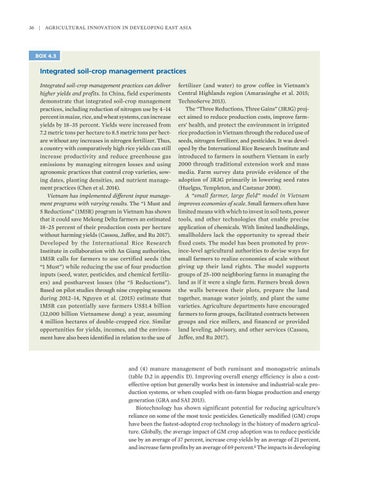36 | Agricultural Innovation in Developing East Asia
BOX 4.3
Integrated soil-crop management practices Integrated soil-crop management practices can deliver higher yields and profits. In China, field experiments demonstrate that integrated soil-crop management practices, including reduction of nitrogen use by 4–14 percent in maize, rice, and wheat systems, can increase yields by 18–35 percent. Yields were increased from 7.2 metric tons per hectare to 8.5 metric tons per hectare without any increases in nitrogen fertilizer. Thus, a country with comparatively high rice yields can still increase productivity and reduce greenhouse gas emissions by managing nitrogen losses and using agronomic practices that control crop varieties, sowing dates, planting densities, and nutrient management practices (Chen et al. 2014). Vietnam has implemented different input management programs with varying results. The “1 Must and 5 Reductions” (1M5R) program in Vietnam has shown that it could save Mekong Delta farmers an estimated 18–25 percent of their production costs per hectare without harming yields (Cassou, Jaffee, and Ru 2017). Developed by the International Rice Research Institute in collaboration with An Giang authorities, 1M5R calls for farmers to use certified seeds (the “1 Must”) while reducing the use of four production inputs (seed, water, pesticides, and chemical fertilizers) and postharvest losses (the “5 Reductions”). Based on pilot studies through nine cropping seasons during 2012–14, Nguyen et al. (2015) estimate that 1M5R can potentially save farmers US$1.4 billion (32,000 billion Vietnamese dong) a year, assuming 4 million hectares of double-cropped rice. Similar opportunities for yields, incomes, and the environment have also been identified in relation to the use of
fertilizer (and water) to grow coffee in Vietnam’s Central Highlands region (Amarasinghe et al. 2015; TechnoServe 2013). The ‘’Three Reductions, Three Gains” (3R3G) project aimed to reduce production costs, improve farmers’ health, and protect the environment in irrigated rice production in Vietnam through the reduced use of seeds, nitrogen fertilizer, and pesticides. It was developed by the International Rice Research Institute and introduced to farmers in southern Vietnam in early 2000 through traditional extension work and mass media. Farm survey data provide evidence of the adoption of 3R3G primarily in lowering seed rates (Huelgas, Templeton, and Castanar 2008). A “small farmer, large field” model in Vietnam improves economies of scale. Small farmers often have limited means with which to invest in soil tests, power tools, and other technologies that enable precise application of chemicals. With limited landholdings, smallholders lack the opportunity to spread their fixed costs. The model has been promoted by province-level agricultural authorities to devise ways for small farmers to realize economies of scale without giving up their land rights. The model supports groups of 25–100 neighboring farms in managing the land as if it were a single farm. Farmers break down the walls between their plots, prepare the land together, manage water jointly, and plant the same varieties. Agriculture departments have encouraged farmers to form groups, facilitated contracts between groups and rice millers, and financed or provided land leveling, advisory, and other services (Cassou, Jaffee, and Ru 2017).
and (4) manure management of both ruminant and monogastric animals (table D.2 in appendix D). Improving overall energy efficiency is also a cost- effective option but generally works best in intensive and industrial-scale production systems, or when coupled with on-farm biogas production and energy generation (GRA and SAI 2013). Biotechnology has shown significant potential for reducing agriculture’s reliance on some of the most toxic pesticides. Genetically modified (GM) crops have been the fastest-adopted crop technology in the history of modern agriculture. Globally, the average impact of GM crop adoption was to reduce pesticide use by an average of 37 percent, increase crop yields by an average of 21 percent, and increase farm profits by an average of 69 percent.8 The impacts in developing

